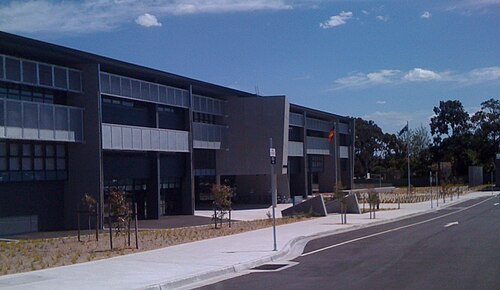| John Monash Science School | |
|---|---|
 | |
 Main entrance to the school | |
| Location | |
 | |
Clayton campus ofMonash University Australia | |
| Coordinates | 37°54′50″S145°07′44″E / 37.91389°S 145.12889°E /-37.91389; 145.12889 |
| Information | |
| Type | Government-funded secondaryday school |
| Established | 2009; 16 years ago (2009) |
| Founders | |
| Specialist | Science and technology |
| Principal | Andrew Chisholm |
| Years | 10–12 |
| Gender | Co-educational |
| Enrolment | c. 640 |
| Houses | Doherty (blue) Flannery (green) Blackburn (purple) Wood (silver) |
| Colour(s) | Navy blue, white, sky blue |
| Affiliations | Monash University |
| Website | www |
 | |
TheJohn Monash Science School is agovernment-funded co-educational academicallyselective and specialist secondaryday school, located on theClayton campus ofMonash University, inMelbourne, Victoria, Australia. The school specialises in science and technologies and is the state's first specialist science secondary school.[1] A joint venture between theGovernment of Victoria and Monash University, the school opened in 2009 with oneYear 10 class;[2] and as of 2010 it was running at its full capacity of approximately 660 students.[3][4] The school is named in honour ofSir John Monash.
It is one of three recently built selective high schools in Victoria alongsideSuzanne Cory High School andNossal High School. The addition of these schools are the result of a policy of expansion, and doubles the number of fully selective government schools in Victoria. Prior to these schools,Mac.Robertson Girls' High School,Melbourne High School and theVictorian College of the Arts Secondary School were the sole selective entry schools in Victoria.
Entry into John Monash Science School is highly selective, with students first being required to sit an entrance exam (administered byEduTest), testing scientific and mathematical amplitude. The top 600 students are invited for an interview, out of which, 200 students will be selected for admission into the school for the following year.
More than 5000 students sat the entrance exam in 2024 for the 200 places on offer in Year 10 (100 males & 100 females), where a 3% rule applies, stating that no more than 3% of the school's Year 10 cohort can be part of a single school. There are also a limited number of places for Year 11, with the number ranging from 30 to 40 students, depending on the cohort size. Typically, more than 400 prospective students apply for Year 11 entrance admission. The 3% rule does not apply to Year 11 entry.
A variety of elective subjects are offered in Year 10 at John Monash Science School which covernanotechnology,marine biology,biomedicine,geology (terraforming mars),bioinformatics,astrophysics,spectroscopy, Pharmaceutical Sciences and Materials Science. Year 10 students also do a year-long project named EEI (Extended Experimental Investigation), this results in a presentation at the John Monash Science School Science Fair.
John Monash Science School is a highly regarded state school in Victoria, consistently achieving strong academic results. In 2024, the school was ranked 4th among all state schools in Victoria and excels in specific VCE subjects. It is ranked 1st in Victoria for VCE Physics and VCE Environmental Science across all schools, 1st in Algorithmics(HESS) among all secondary schools, 2nd in Victoria for VCE Mathematical Methods, and third in the state for VCE Psychology. Additionally, the school frequently ranks within the top 10 for VCE Chemistry, Specialist Maths and Biology in the state.[5][6]
The student body is divided into four houses:[7][8]
Each house is named after an accomplished Australian scientist:Tim Flannery,Elizabeth Blackburn,Fiona Wood, andPeter Doherty respectively.[8]
On 13 February 2013, the NBN Virtual School of Emerging Sciences (NVSES) was launched in a coalition effort between John Monash Science School, Monash University, andPearson Education.[9] Utilizing the Australian government'sNational Broadband Network's (NBN) educational facilities, lessons are taught by JMSS staff and Monash University scientists via internet to schools all around Australia. Two subjects are currently offered:astrophysics (which leads on toquantum physics) andnanoscience (leading on tonanotechnology).